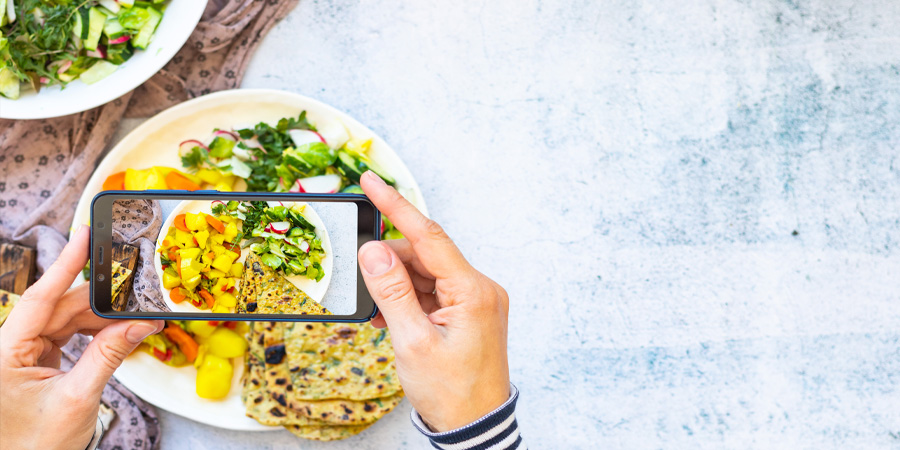
In just a few years, social media have turned into an information media, especially among young people. More particularly, Instagram, TikTok and Youtube are used to search for information on health, news and food. In addition to this trend, and given the increased prevalence of obesity, many food-related messages are disseminated on these platforms, especially those related to “healthy eating”. During the Benjamin Delessert 2023 Annual Conference, Pascale Ezan – Professor at the University of Rouen, presented an overview of the impacts of this phenomenon on eating habits.
Over the past twenty years, social media has become an essential part of our daily lives. For example, 18–24-year-olds spend several hours a day on these platforms. They mainly follow influencers – individuals with a high number of followers who have become authority figures when talking about food. Influencers have taken over online platforms to discuss physical activity, fitness, balanced nutrition, and well-being in a more general way.
social media users in 2023. (Datareportal, 2023)
social media users in France.
“Healthy” posts on Instagram.
Social media: a pathway to raise awareness about food and cooking for young people
As part of the ALIMNUM project (see box), Pascale Ezan and her colleagues are studying the relationship between food and digital technology, with the aim to determine how social media shape the relationship between young people and food. The findings of this project show that information related to diet and physical activity is widely disseminated on social media. The content includes public health recommendations (eat at least 5 fruit and vegetables a day, reduce your consumption of ultra-processed products, etc.) but also tips on how to cook quickly, easily and on a low budget while considering healthy eating. Many easy ideas of recipes with step-by-step guidelines are floating around, especially on Instagram, providing a wide range of inspiration for cooking.
Influencers that are approachable and building social connection with their followers
Unlike health professionals, influencers have a horizontal communication, i.e., they establish an equal relationship with their followers. Interviews conducted within the framework of the ALIMNUM project show that influencers are perceived as approachable, which favours a close relationship between the content creator and his community.
Moreover, influencers disseminate content focusing on interests shared with their followers which reinforces the closeness and authenticity of the exchanges. Besides food, it can be for instance about sports, fashion, decoration, gardening and many other topics.
Social media as a motivational tool, using targeted staging
The offbeat, humorous and non-judgmental tone of influencers is also a trait that makes it easier for their community to identify with and listen to the messages they convey. The rich content offered by influencers is rooted in personal experiences, sometimes with trials and mistakes. By sharing their meals and routines, influencers set an example and demonstrate how important healthy eating and physical activity are to health.
Their content is a real motivator, inviting people to do the same by mimicry. As Ms Ezan pointed out, the guidance and support provided by influencers, like coaches, encourages people to continue their efforts in their new routines.
Youtube: few contents respect and are in line with dietary guidelines
Nevertheless, it is important to keep in mind that influencers are not always right. As reported by Ms Ezan, the analysis of 86 Youtube videos “What I eat in a day” revealed that most of these videos did not meet dietary guidelines.
The same observation applies to protein, fat and carbohydrate intake, but also to micronutrients. This finding seems alarming because female influencers creating those videos are considered experts on the subject and therefore have a strong influence on their communities (Maxime David, 2021). According to the corpus of videos analysed, the vision of a “healthy” diet seems inaccurate and not in line with dietary guidelines: inappropriate balance of proteins-carbohydrates-lipids, “too much” vegetarian diet leading to deficiencies, promotion of supplements that are mostly useless, and emphasis on the aesthetics of the photographs and videos instead of the nutritional quality and balance of meals.
A desire for thinness and a need to control
As Mrs Ezan also pointed out during her speech, in these contents, eating healthy is frequently linked with the desire to lose weight, although this intention is not mentioned explicitly. The different Youtube videos analysed show several common points: “hunger-cutting” tricks to reach satiety (, drinking a large glass of water when hungry, eating chia seeds and low-calorie foods (courgettes, salad, konjac, etc.), all to eat low-calorie dishes that will still fill the stomach. This desire for thinness is rooted above all in the search for the “ideal” body that society has shaped. The need to control food intake also seems to be a predominant topic in the various YouTube videos studied. The concept of healthy eating is opposed to deviations and pleasure, which tend to occur on weekends, and therefore completely erasing the hedonic dimension of food. Female Youtubers state that they are “getting out of line” and feel guilty about breaking the momentum of the week (Maxime David, 2021). This over-control (which can also be restrictive) is nevertheless dangerous and can be one of the causes of eating disorders.
Thus, the multitude of diet-related messages on social media, mostly conveyed by influencers (who are rarely health professionals), can lead to risky eating practices that deviate from public health dietary guidelines. The silent quest for a body shaped according to body standards can have significant psychological impacts (lowered self-confidence, body dissatisfaction) which can lead to eating disorders.
Bringing together health professionals and influencers to leverage expertise and regulate speech
To regulate the speeches on social media, Ms Ezan pointed out two important areas of improvement:
- Scientific experts should invest in the various social media;
- Health professionals and influencers should join forces.
Capitalising on influencers allows us to reach a wide and young audience that is difficult to target outside of social media with health promotion actions. Their followers would probably be more inclined to follow their lead and reproduce their behaviours since they are appreciated by their communities and are considered as “role models”. For instance, the partnership between Squeezie and the national campaign ” Eat and Move ” is a promising example, as 30% of 18–25-year-olds said they had tried one or more healthy recipes following the videos.
ALIMNUM is a multi-disciplinary project coordinated by Pascale Ezan which brings together 20 researchers from 5 laboratories: marketing, public health, psychology, food sociology and digital sociology. It has been selected by the French National Research Agency for funding from 2022 to 2026. This project aims to provide an in-depth analysis of the contribution of virtual communities on the eating practices of students (18-25 years old) and their impact on the risk of developing an eating disorder. Ultimately, the goal is to offer early management of this risk through a screening tool.




